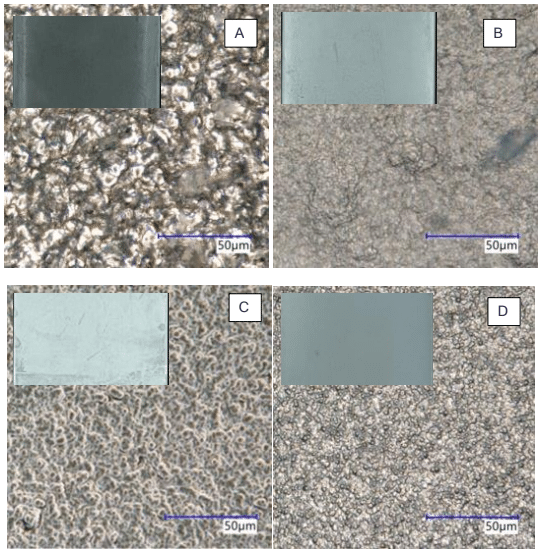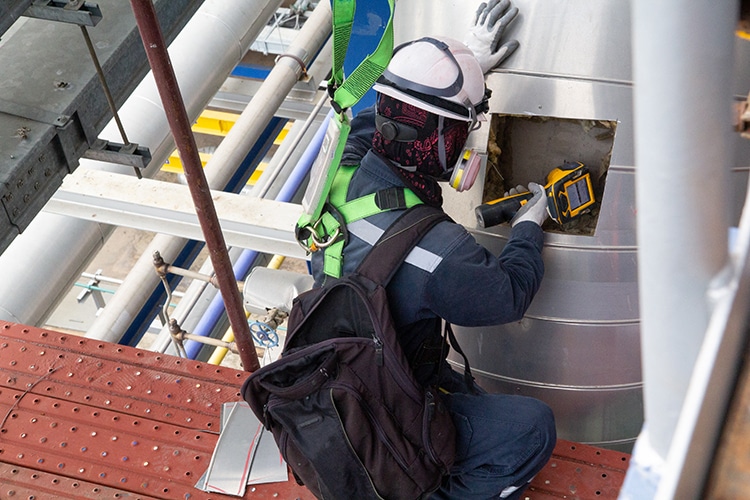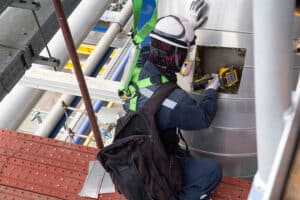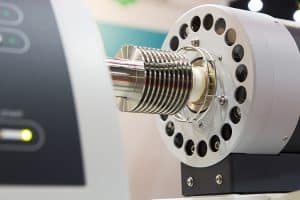In the second installment of our blog series exploring testing techniques for assessing chromium coating quality, we will delve into microstructural analysis, porosity testing, chemical composition analysis, and roughness measurement.
These testing techniques, utilized by engineers at the Armoloy Innovation Center, play a crucial role in guaranteeing the overall quality, performance, and reliability of chromium-coated products. By providing insights into the structural integrity and composition of the coatings, these analyses ensure the durability and effectiveness of chromium-coated materials.
Read our previous post, where we covered five testing techniques utilized by engineers at the Armoloy Innovation Center.
6. Microstructural Analysis
Microstructural analysis is a pivotal testing technique for evaluating chromium coatings’ quality, thickness, uniformity, and potential failure mechanisms — especially in industries where these coatings are subjected to demanding environmental conditions or mechanical stresses.
What can Microstructural Analysis Reveal?
A powerful tool for a detailed examination of chromium coatings, microstructural analysis provides critical information across several key aspects:
- Coating thickness. Microstructural analysis allows for precise measurement and assessment of the thickness of chromium coatings. This parameter is vital in determining the coating’s effectiveness in providing the desired protection and functionality. Accurate knowledge of coating thickness is essential for ensuring compliance with specified standards and requirements.
- Defects and inhomogeneities. Microstructural analysis helps identify and characterize defects and inhomogeneities within chromium coating, including cracks, voids, or irregularities. Understanding these imperfections is crucial for evaluating the coating’s integrity and durability.
- Adhesion. Poor adhesion can lead to premature coating failure and compromise the overall performance of the coated product. Microstructural analysis provides insights into the bonding strength and coating integrity by examining the interface between the chromium coating and the substrate at a microscopic level.
- Coating failure. Finally, microstructural analysis is instrumental in understanding the mechanisms and causes of coating failure. It helps identify the factors contributing to degradation, such as corrosion, wear, or chemical exposure. This information is invaluable for improving the design and formulation of chromium coatings to enhance their resistance to specific environmental conditions or stresses, ultimately prolonging the lifespan of coated products.
7. Porosity Testing
The presence of pores, voids, or gaps within chromium coating can compromise its ability to provide superior protection against corrosion and mechanical wear. Porosity testing is indispensable; it helps identify potential pathways for corrosive agents to infiltrate the coating, thereby safeguarding the substrate from damage.
Chromium coatings, known for their hardness, wear resistance, and corrosion protection, require minimal porosity to fulfill their intended functions, particularly in protective applications.
Several porosity tests play a vital role in assessing the integrity of chromium coatings, each offering unique insights into the coating’s resistance to porosity.
- Microscopic examination. This test involves the visual inspection of the chromium coating at a microscopic level. It directly observes pores, voids, or gaps within the coating structure.
- Ferroxyl test. A chemical method used to detect the presence of porosity in chromium coatings, the Ferroxyl test involves applying a potassium ferricyanide solution to the coated surface. If there is any porosity, the solution reacts with the underlying metal, forming visible reddish-brown spots. This test is particularly sensitive to the presence of minute pores and is valuable for quickly identifying areas of potential concern in the coating.
- Salt Spray/CASS (Cyclic Accelerated Salt Spray) Test. CASS tests simulate harsh environmental conditions by subjecting the chromium-coated surface to a corrosive salt-laden atmosphere. The prolonged exposure to salt spray or cyclic conditions helps evaluate how well the coating protects against the intrusion of corrosive agents. These tests are especially relevant for coatings used in marine or industrial environments.
What can Porosity Testing Reveal?
Porosity testing plays a pivotal role in revealing critical information about chromium coatings, offering insights into various aspects essential for assessing their quality and performance, including:
- Plating parameters. Porosity testing provides valuable feedback on the plating parameters used in the coating process. By identifying and quantifying any porosity present in the coating, manufacturers can gain insights into the effectiveness of their plating techniques.
- Correlation of corrosion protection to coating thickness. The extent of porosity can directly impact the coating’s ability to resist corrosive agents. Understanding this correlation is crucial for optimizing coating thickness to meet specific performance requirements.
- Compliance with standards. A key component of quality control, porosity testing ensures coatings comply with industry standards and specifications.
8. Chemical Composition Analysis
Chemical composition analysis is an examination aimed at verifying the elemental makeup of chromium coatings, ensuring the accurate proportion of chromium and other elements or compounds employed in the coating process.
This meticulous assessment is essential to guarantee the integrity and performance of the coating. Any chromium composition or impurities deviations can adversely affect the coating’s corrosion resistance, hardness, and adhesion properties. By scrutinizing the chemical composition, manufacturers can ensure that the chromium coatings adhere to specified standards.
Various types of chemical composition analysis play a crucial role in ensuring the accuracy and quality of chromium coatings. Here are brief explanations of some standard techniques:
- X-Ray Fluorescence (XRF). XRF is a non-destructive analytical technique used to determine the elemental composition of materials. In the context of chromium coatings, XRF can quickly and accurately identify the presence and concentration of different elements. This method is valuable for assessing the overall composition of the coating, including chromium and any other elements used in the coating process.
- Energy-dispersive X-ray Spectroscopy (EDS/EDX). EDS/EDX is a technique that uses X-rays to identify and quantify the elements present in a sample. In examining chromium coatings, EDS provides detailed information about the elemental composition of the coating at a microscopic level. This technique is beneficial for investigating localized variations in composition and identifying coating impurities or anomalies.
- Inductively Coupled Plasma (ICP) Spectroscopy. ICP spectroscopy is a highly sensitive and precise technique used to analyze elements in a sample quantitatively. In the context of chromium coatings, ICP can provide detailed information about the concentration of various elements, allowing for a thorough assessment of the coating’s chemical composition. This method is beneficial for detecting trace elements and ensuring that the coating meets specified standards.
- Atomic Absorption Spectroscopy (AAS). AAS is a technique that measures light absorption by atoms in a sample. It is commonly used to quantitatively analyze specific elements, including chromium. In examining chromium coatings, AAS can provide accurate measurements of chromium content, verifying the coating’s composition and ensuring that it aligns with the intended formulation.
What can Chemical Composition Testing Reveal?
Chemical composition testing of chromium coatings provides valuable insights into several key aspects:
- Plating bath health. The chemical composition of the coating can provide information on plating bath health. Lack of uniformity, the presence of impurities, degradation in corrosion resistance, and poor adherence to the substrate, for example, are all clues that something may be amiss with the plating bath.
- Compliance with standards. Chemical composition testing also ensures chromium coatings comply with industry standards and specifications.
- Quality control. By regularly analyzing the coating’s elemental makeup, manufacturers can identify any deviations or anomalies that may affect the coating’s properties.
9. Roughness Measurement
Roughness measurement is crucial in evaluating chromium coatings applied in numerous applications, where surface characteristics impact performance and aesthetics. This process quantifies the surface texture to ensure it meets specific criteria for smoothness, influencing properties such as adhesion, friction, wear resistance, and appearance.
The roughness of chromium coatings significantly affects corrosion resistance, with smoother surfaces providing superior protection. In decorative applications, it directly influences visual and tactile quality, while in functional uses, it impacts interactions with other surfaces, affecting factors such as friction and wear behavior.
In short, roughness measurement ensures that chromium coatings balance functional and aesthetic requirements in diverse applications. Some methods of measuring surface roughness include:
- Contact profilometry. Contact profilometry is a widely used method for measuring surface roughness in chromium coatings. This technique involves direct contact between a stylus and the coated surface, and the stylus traces the surface contours. As it moves along the surface, the stylus detects variations in height, allowing for the precise quantification of roughness. Contact profilometry is known for its accuracy and reliability in capturing fine surface details.
- Non-contact optical methods. Non-contact optical methods utilize advanced technologies to measure surface roughness without direct contact with the coating, including confocal microscopy, interferometry, and structured light methods. Non-contact optical methods are advantageous for their high precision and non-invasive nature, preserving the integrity of the coating.


macroscopic appearance of each coupon. Based on visual appearance, coupons B, C, and D are considered acceptable.
- Atomic Force Microscopy (AFM). In the context of chromium coatings, AFM can offer insights into nanoscale features and variations. This method involves a sharp tip that scans the surface, detecting forces between the tip and the atoms on the surface. AFM is particularly valuable for capturing fine details, making it suitable for research and development applications.
What can Roughness Measurement Reveal?
Roughness measurement of chromium coatings yields critical insights into various aspects such as:
- Roughness and coating thickness relationships. Understanding how surface roughness correlates with the thickness of the chromium coating is essential for optimizing the coating process. It provides valuable information on how changes in thickness might impact the surface texture, influencing properties like adhesion, wear resistance, and overall performance.
- Quality control. By quantifying surface roughness, manufacturers can establish baseline criteria for the acceptable quality of coated products. Deviations from these standards can indicate potential issues in the coating process, allowing for timely adjustments and preventive measures.
- Compliance with specifications. Roughness measurement provides a quantitative means of assessing whether the coated surfaces meet the criteria outlined in the industry standards. This adherence to specifications ensures that chromium-coated products consistently deliver the required performance characteristics in diverse applications.
- Post-plating finishing processes. Whether it’s polishing, grinding, or other surface treatments applied after the coating process, roughness measurement provides feedback on the success of these finishing steps. It ensures that the final surface texture aligns with the desired specifications, whether for functional purposes, such as in machinery components or for aesthetic reasons.
Ensuring Quality Throughout the Production Process
Collaborating with the Innovation Center of the Armoloy Corporation, our Process Engineering Facilities strive to pinpoint and record crucial process parameters, ensuring rigorous quality control and minimizing variations throughout all production phases.
From research and development to long-term performance assessments, Electrolizing is here to meet the demands of your industrial and commercial applications.






